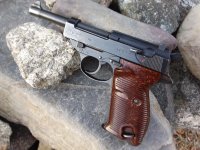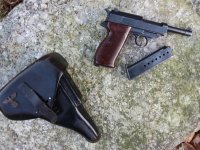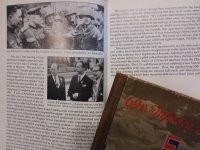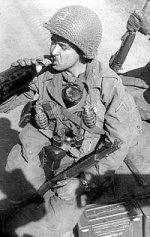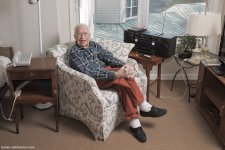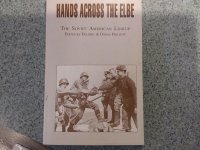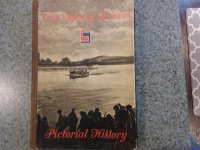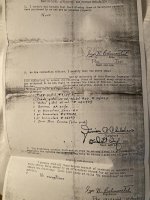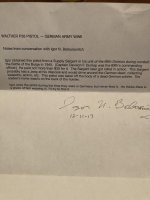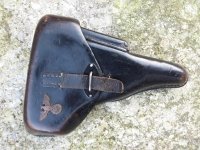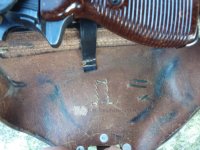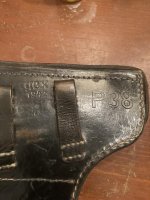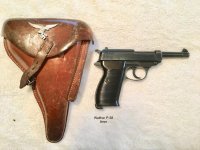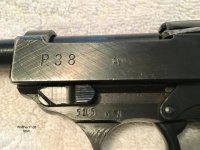Murdock
Member
The soldier who brought this P-38 back was PFC Igor Belousovich, of the 69th Infantry Division. On April 25, 1945 he was a member of one of the three patrols sent to make contact with the approaching Soviet Red Army at the Elbe river.
Igor's father had been a White Russian cavalry officer, and later a pilot in the Czar's air force. The Russian Revolution convinced him to seek more favorable career opportunities in America. Igor was raised speaking perfect Russian, and was the only one on the patrol able to communicate with the Soviets. He was also the only one with a camera. The photos frequently shown in the press on the anniversay of the first contact with the Soviets are all Igor's.
If you want to fall down a rabbit hole, simply google Igor Belousovich 69th Infantry Division, or Igor Belousovich, US State Department. Some of the information that comes up is Russian propaganda, and the English translations are awkward in places. Lots of good photos, though.
Igor had a dry sense of humor. When I asked him how he came into possession of this P-38 he said, "I got it from a German soldier. He didn't object."
The gun is a Spreewerke product, rather than the Walther or Mauser variety, showing typically rougher wartime finish compared to the guns produced by the other two arms plants. Not too bad though, given it was produced by Polish slave labor in Czechoslovakia. Serial number places it as made in December, 1942. The holster also shows a 1942 date of production.
The gun came to me unexpectedly through my personal relationship with Igor Belousovich and his family. It was offered to me after Igor passed, but at the time I advised the family to keep it among themselves. Over time it was offered to me again because no one in the family had an interest in keeping it, and they knew I valued my relationship with Igor, and the history it represents.
I would appreciate any advice or recommendation from some of the advanced collectors who are members here on how to best manage my custodianship of this pistol.
The photos below show a bit about Igor and his pistol. Please note the photo of a "just glad to be alive" 23-year-old PFC Belousovich on the back of a Sherman tank with some buddies in late April or early May 1945. He's wearing the holstered pistol in that photo.
Igor's father had been a White Russian cavalry officer, and later a pilot in the Czar's air force. The Russian Revolution convinced him to seek more favorable career opportunities in America. Igor was raised speaking perfect Russian, and was the only one on the patrol able to communicate with the Soviets. He was also the only one with a camera. The photos frequently shown in the press on the anniversay of the first contact with the Soviets are all Igor's.
If you want to fall down a rabbit hole, simply google Igor Belousovich 69th Infantry Division, or Igor Belousovich, US State Department. Some of the information that comes up is Russian propaganda, and the English translations are awkward in places. Lots of good photos, though.
Igor had a dry sense of humor. When I asked him how he came into possession of this P-38 he said, "I got it from a German soldier. He didn't object."
The gun is a Spreewerke product, rather than the Walther or Mauser variety, showing typically rougher wartime finish compared to the guns produced by the other two arms plants. Not too bad though, given it was produced by Polish slave labor in Czechoslovakia. Serial number places it as made in December, 1942. The holster also shows a 1942 date of production.
The gun came to me unexpectedly through my personal relationship with Igor Belousovich and his family. It was offered to me after Igor passed, but at the time I advised the family to keep it among themselves. Over time it was offered to me again because no one in the family had an interest in keeping it, and they knew I valued my relationship with Igor, and the history it represents.
I would appreciate any advice or recommendation from some of the advanced collectors who are members here on how to best manage my custodianship of this pistol.
The photos below show a bit about Igor and his pistol. Please note the photo of a "just glad to be alive" 23-year-old PFC Belousovich on the back of a Sherman tank with some buddies in late April or early May 1945. He's wearing the holstered pistol in that photo.
Attachments
Last edited:

